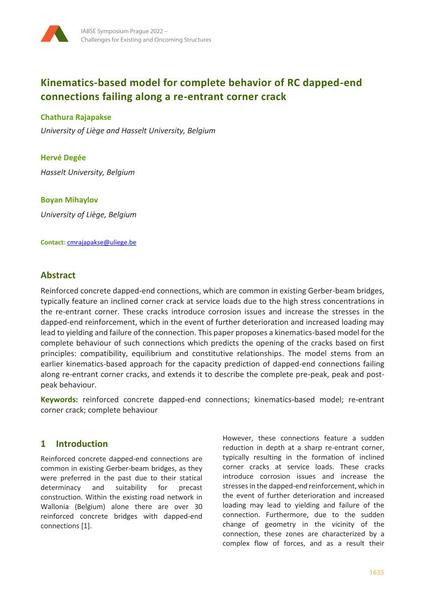Kinematics-based model for complete behavior of RC dapped-end connections failing along a re-entrant corner crack

|
|
|||||||||||
Bibliographic Details
| Author(s): |
Chathura Rajapakse
(University of Liège and Hasselt University, Belgium)
Hervé Degée (Hasselt University, Belgium) Boyan Mihaylov (University of Liège, Belgium) |
||||
|---|---|---|---|---|---|
| Medium: | conference paper | ||||
| Language(s): | English | ||||
| Conference: | IABSE Symposium: Challenges for Existing and Oncoming Structures, Prague, Czech Republic, 25-27 May 2022 | ||||
| Published in: | IABSE Symposium Prague 2022 | ||||
|
|||||
| Page(s): | 1635-1642 | ||||
| Total no. of pages: | 8 | ||||
| DOI: | 10.2749/prague.2022.1635 | ||||
| Abstract: |
Reinforced concrete dapped-end connections, which are common in existing Gerber-beam bridges, typically feature an inclined corner crack at service loads due to the high stress concentrations in the re-entrant corner. These cracks introduce corrosion issues and increase the stresses in the dapped-end reinforcement, which in the event of further deterioration and increased loading may lead to yielding and failure of the connection. This paper proposes a kinematics-based model for the complete behaviour of such connections which predicts the opening of the cracks based on first principles: compatibility, equilibrium and constitutive relationships. The model stems from an earlier kinematics-based approach for the capacity prediction of dapped-end connections failing along re-entrant corner cracks, and extends it to describe the complete pre-peak, peak and post- peak behaviour. |
||||
| Keywords: |
reinforced concrete dapped-end connections kinematics-based model re-entrant corner crack complete behaviour
|
||||
| Copyright: | © 2022 International Association for Bridge and Structural Engineering (IABSE) | ||||
| License: | This creative work is copyrighted material and may not be used without explicit approval by the author and/or copyright owner. |
||||
